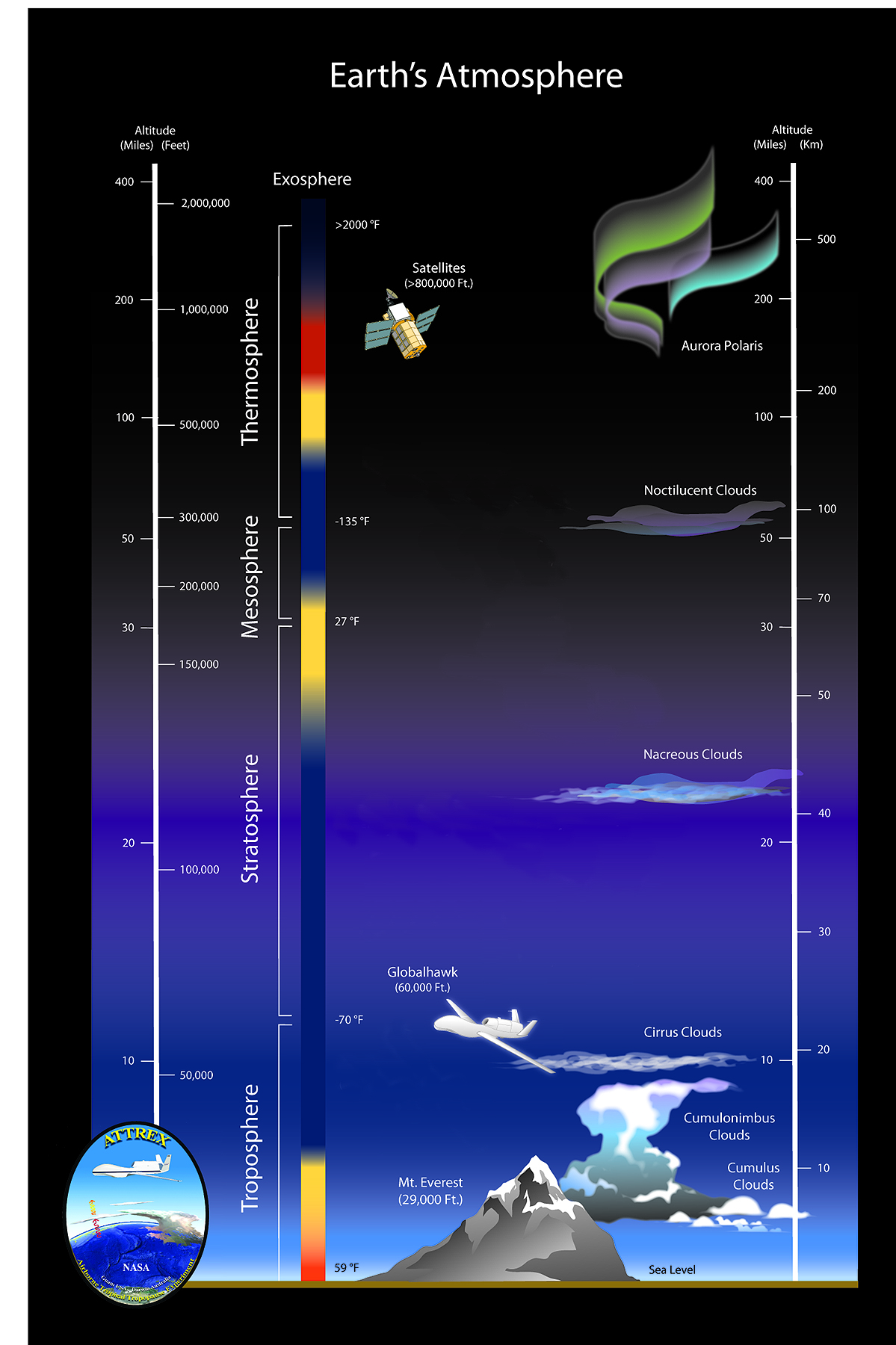Which Is The Outermost Layer Of The Atmosphere

Which is the outermost layer of the atmosphere
Ionosphere is the outermost layer of earth's atmosphere. This layer contains a high concentration of ions and free electrons and is able to reflect radio waves. It lies above mesosphere and extends from 80 to 1,000 km above the earth's surface.
What is the 2nd outermost layer of the atmosphere?
Stratosphere. The stratosphere is the second major strata of air in the atmosphere. It extends above the tropopause to an altitude of about 30 miles (50 km) above the planet's surface. The air temperature in the stratosphere remains relatively constant up to an altitude of 15 miles (25 km).
Which layer is known as ionosphere?
The ionosphere (/aɪˈɒnəˌsfɪər/) is the ionized part of the upper atmosphere of Earth, from about 48 km (30 mi) to 965 km (600 mi) above sea level, a region that includes the thermosphere and parts of the mesosphere and exosphere.
Which layer is called ionosphere Why?
What is the ionosphere? The ionosphere is a very active part of the atmosphere, and it grows and shrinks depending on the energy it absorbs from the Sun. The name ionosphere comes from the fact that gases in these layers are excited by solar radiation to form ions, which have an electrical charge.
What are the 4 atmosphere layers?
From lowest to highest, the major layers are the troposphere, stratosphere, mesosphere, thermosphere and exosphere.
- Troposphere.
- Stratosphere. ...
- Mesosphere. ...
- Thermosphere. ...
- Exosphere. ...
- The Edge of Outer Space.
What are the 3 layers of the atmosphere called?
The atmosphere can be divided into layers based on its temperature, as shown in the figure below. These layers are the troposphere, the stratosphere, the mesosphere and the thermosphere. A further region, beginning about 500 km above the Earth's surface, is called the exosphere.
Where is the ozone layer?
The ozone layer sits in the stratosphere between 15 km and 30 km above the earth, and shields us and other living things from the sun's harmful ultraviolet radiation. Ozone layer depletion could have serious effects on human health and the environment.
What is the ozone layer?
The ozone layer is a thin part of the Earth's atmosphere that absorbs almost all of the sun's harmful ultraviolet light. "Ozone holes" are popular names for areas of damage to the ozone layer.
What is the range of F layer?
The F1 layer is the lower sector of the F layer and exists from about 150 to 220 km (100 to 140 miles) above the surface of the Earth and only during daylight hours.
What's the first layer of the atmosphere?
The troposphere starts at the Earth's surface and extends 8 to 14.5 kilometers high (5 to 9 miles). This part of the atmosphere is the most dense. Almost all weather is in this region.
What is the thermosphere also called?
The lower part of the Thermosphere, a layer of ionised air extending from the Mesopause to approximately 600km is also known as the Ionosphere, while the upper part of the Thermosphere is also known as the Exosphere.
Is thermosphere and ionosphere same?
The thermosphere is directly above the mesosphere and below the exosphere. Earth's ionosphere, composed of several regions overlaps with and shares the same space as the thermosphere. The thermosphere is a layer of Earth's atmosphere that is directly above the mesosphere and below the exosphere.
Who discovered ionosphere?
By studying the superposition, or interference, of radio waves that had taken different paths, Edward Appleton established the existence of this layer—the ionosphere—in 1924. In 1927 he demonstrated that an additional layer existed outside the one discovered previously.
Is the thermosphere the biggest layer?
The thermosphere is the second highest layer of Earth's atmosphere and extends from the mesopause (which separates it from the mesosphere) at an altitude of approximately 260,000ft up to the thermopause at an altitude that ranges from 1,600,000 to 3,300,000ft.
What is in the exosphere?
The exosphere layer is mainly composed of extremely low densities of hydrogen, helium and several heavier molecules including nitrogen, oxygen and carbon dioxide closer to the exobase. The atoms and molecules are so far apart that they can travel hundreds of kilometers without colliding with one another.
What is called atmosphere?
An atmosphere is the layers of gases surrounding a planet or other celestial body. Earth's atmosphere is composed of about 78% nitrogen, 21% oxygen, and one percent other gases.
Where is the ionosphere?
Located within the thermosphere, the ionosphere is made of electrically charged gas particles (ionized). The ionosphere extends from 37 to 190 miles (60-300 km) above the earth's surface. It is divided into three regions or layers; the F-Region, E-Layer and D-Layer.
What is the layers of the earth?
The structure of the earth is divided into four major components: the crust, the mantle, the outer core, and the inner core. Each layer has a unique chemical composition, physical state, and can impact life on Earth's surface.
Why is the stratosphere called the stratosphere?
Above the troposphere and below the mesosphere, we have the stratosphere. “Strat” means layer. This layer of our atmosphere has its own set of layers. There are no storms or turbulence here to mix up the air, so cold, heavy air is at the bottom and warm, light air is at the top.
What is the Colour of ozone?
It is a pale blue gas and consists of three oxygen atoms. Formed in the ozone layer of the stratosphere, it is harmful to life. Ozone, O3, is an allotrope of oxygen. Ozone has pungent an odor, and its color is blue- black in its solid and liquid form.













Post a Comment for "Which Is The Outermost Layer Of The Atmosphere"